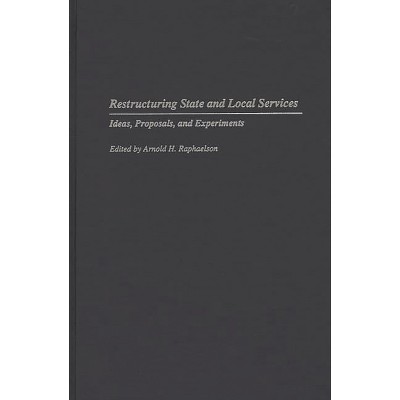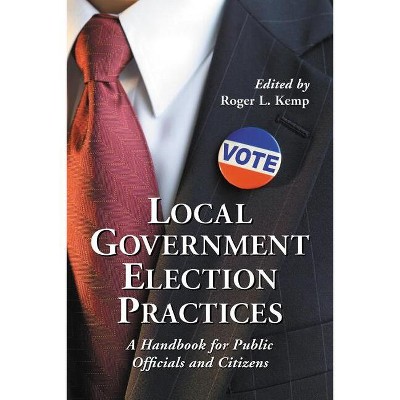Sponsored

Collective Bargaining in State and Local Government - by John Paick Piskulich (Hardcover)
In Stock
Sponsored
About this item
Highlights
- Almost half of government employees are represented by labor organizations, and public-sector unions act as a significant force in the effective operation of government and can exert substantial control over labor costs and procedures in the workplace.
- About the Author: JOHN PATRICK PISKULICH is Assistant Professor of Political Science at Oakland University.
- 144 Pages
- Political Science, Labor & Industrial Relations
Description
About the Book
Almost half of government employees are represented by labor organizations, and public-sector unions act as a significant force in the effective operation of government and can exert substantial control over labor costs and procedures in the workplace. The response by state and local officials has varied greatly, with collective bargaining frameworks existing as a patchwork of experiments--from mandated collective bargaining to outright prohibition. While their policy actions seem to recognize the benefits of bilateral negotiation, the spectre of service disruption continues to haunt them. Because public-sector bargaining is a recent development, policy analysts lack a firm handle on policymaking in this sphere. Piskulich examines the dimensions of state and local public-sector labor policy and explores policies that enable policymakers to manage the collective bargaining process in line with their goals.
This study looks at the three questions most crucial to policy efficacy: what governments do; why they do it; and what difference it makes. Three central findings emerge from the issue of what governments do. The evidence indicates increasing enactment of labor policy over time across subnational jurisdictions. Policy across occupations is stable, though there are important differences in the willingness of the employer to tolerate strikes and resolve impasses. Third, it appears that policy actors make three distinct sets of decisions: basic policy; the availability and mechanics of the arbitration mechanism; and the degree to which they provide public unions with institutionalized union security. The answer to why they do it hinges on factors of ideology and policy; the effects are mitigated when unionization is considered. What difference it makes, examines two variables in particular: unionization and service disruption. Piskulich reaches three conclusions: that a majority of subnational jurisdictions see value in collective bargaining for their public employees, that unions can help themselves, and that unionization and disruption vary with policies implemented. These findings provide insight into the larger questions on the role of organized labor in American democracy.
Book Synopsis
Almost half of government employees are represented by labor organizations, and public-sector unions act as a significant force in the effective operation of government and can exert substantial control over labor costs and procedures in the workplace. The response by state and local officials has varied greatly, with collective bargaining frameworks existing as a patchwork of experiments--from mandated collective bargaining to outright prohibition. While their policy actions seem to recognize the benefits of bilateral negotiation, the spectre of service disruption continues to haunt them. Because public-sector bargaining is a recent development, policy analysts lack a firm handle on policymaking in this sphere. Piskulich examines the dimensions of state and local public-sector labor policy and explores policies that enable policymakers to manage the collective bargaining process in line with their goals.
This study looks at the three questions most crucial to policy efficacy: what governments do; why they do it; and what difference it makes. Three central findings emerge from the issue of what governments do. The evidence indicates increasing enactment of labor policy over time across subnational jurisdictions. Policy across occupations is stable, though there are important differences in the willingness of the employer to tolerate strikes and resolve impasses. Third, it appears that policy actors make three distinct sets of decisions: basic policy; the availability and mechanics of the arbitration mechanism; and the degree to which they provide public unions with institutionalized union security. The answer to why they do it hinges on factors of ideology and policy; the effects are mitigated when unionization is considered. What difference it makes, examines two variables in particular: unionization and service disruption. Piskulich reaches three conclusions: that a majority of subnational jurisdictions see value in collective bargaining for their public employees, that unions can help themselves, and that unionization and disruption vary with policies implemented. These findings provide insight into the larger questions on the role of organized labor in American democracy.Review Quotes
?This short volume addresses "the major causes and consequences of public sector labor policy." Following a review of selected literature, Piskulich (political science, Oakland University) describes the statutory framework with respect to public sector bargaining at the state and local levels. He then examines determinants of policy, largely confirming the conclusions of prior research. The final segment of the analysis deals with the impact of policy decisions, although here impact is defined narrowly, as impact of policy on the establishment of collective bargaining, and on the incidence and severity of conflict.... The book is very well written and well organized, presenting a clear and logical way for analyzing policy, its antecedents, and certain of its effects, Short but useful bibliography.?-Choice
"This short volume addresses "the major causes and consequences of public sector labor policy." Following a review of selected literature, Piskulich (political science, Oakland University) describes the statutory framework with respect to public sector bargaining at the state and local levels. He then examines determinants of policy, largely confirming the conclusions of prior research. The final segment of the analysis deals with the impact of policy decisions, although here impact is defined narrowly, as impact of policy on the establishment of collective bargaining, and on the incidence and severity of conflict.... The book is very well written and well organized, presenting a clear and logical way for analyzing policy, its antecedents, and certain of its effects, Short but useful bibliography."-Choice
About the Author
JOHN PATRICK PISKULICH is Assistant Professor of Political Science at Oakland University. He was educated at the University of Missouri-Columbia and the State University of New York at Binghamton. The American Association of University Professors is the fifth (and only public) union of which he has been a member.Shipping details
Return details
Frequently bought together

Trending Non-Fiction

















